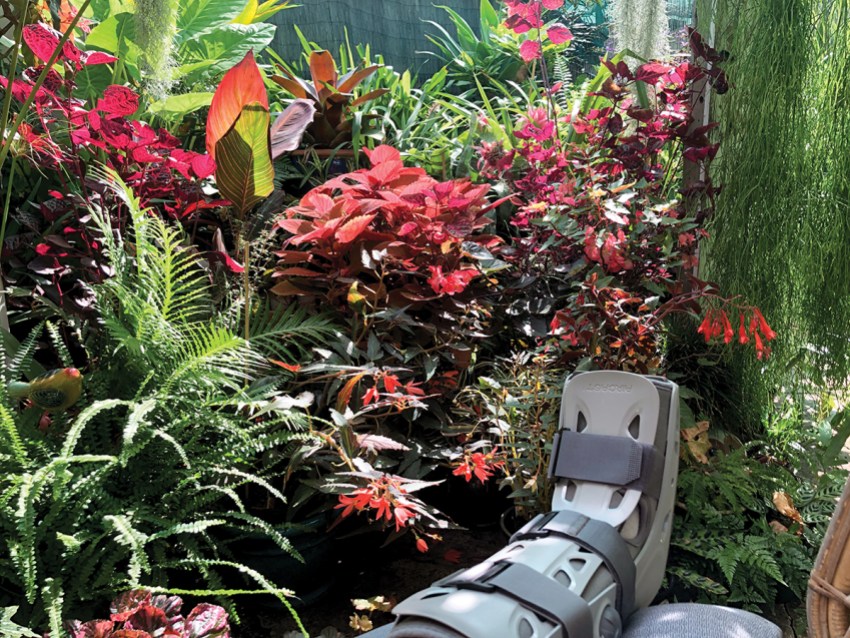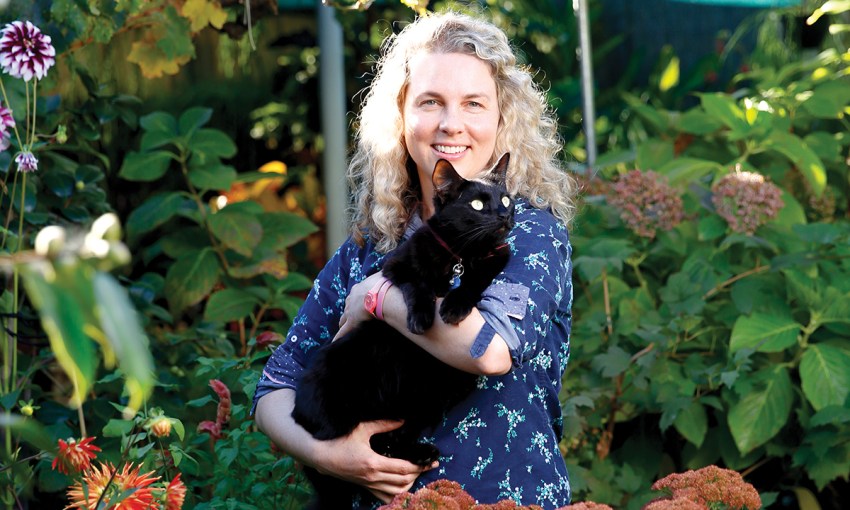We all know that gardening is good for our physical health, but it took some enforced downtime to teach Elly Potter more about the mental health benefits, too.
Gardening on one leg
Until recently, an average day for me began with an early morning stroll through my garden, cup of tea in hand and Cosmo the cat weaving in and around my legs as we conduct our daily outdoor inspections.
Then, I’d head out to garden for clients, or up to the nursery where I work part time. On days off, I’d usually be found pottering around my own garden.
However, all garden activities came to a grinding halt when I broke my ankle.

The injury was a silly one; I inelegantly tripped on a door snake in our hallway, twisting and falling awkwardly. X-rays revealed the need for surgery and the installation of some gnarly metal hardware with a long period of recovery downtime. This was not the news a gardener wants to hear!
Not being able to garden has been interesting. My immediate thought, when the accident first happened was, “How on earth am I going to water my (600+)* pot plants?”.
My other half, Paul, though definitely not a gardener has been a very good sport and is taking his watering duties seriously, despite being pretty miffed at some of my instructions, which to a non-gardener might seem a bit nonsensical:
“Empty that saucer, or the roots will rot, but make sure the saucer for the carnivorous plants is filled up at all times, but with filtered water only” or “Keep the tropical plants moist, except for the begonias – let them dry out first.” (There are about 20 different begonias of vastly different shapes and sizes, mixed in randomly with the tropical plants). Luckily for me, Paul has the patience of a saint.
I’ve also been very fortunate to have some stellar help from dear gardening friends and neighbours, for which I am extremely grateful. Some stopped by nearly every day to help with watering and, as a bonus, I got to enjoy their company. Fellow nursery staff worked extra shifts to fill in for me. I owe them all, big time.
In contrast to the watchful care the pot plants received from friends, most garden plants were left to fend largely for themselves. I’ve been surprised by just how little water some of them tolerated. The best performers have been Agastache spp., Salvia discolor and Salvia leucantha. These plants received water twice over a six-week period in summer!
I was also surprised at how little Sedum spectabile “Autumn Joy” got by on – usually I’d water it once a week, but it received far less and still looks good. Another standout was good old shrimp plant (Justicia brandegeeana syn. Beloperone guttata). Despite receiving far less water than usual, it remained looking good and covered in colourful bracts, to the delight of the local New Holland honeyeaters and eastern spinebills who sip nectar from the small white flowers hidden within.
Other plants didn’t cope so well with their newly imposed water rations. I’ll never understand why lamb’s ear Stachys byzantina is often touted as being drought resistant. In my experience, extended periods without irrigation render it very sad looking indeed. My current patch of this plant looks more like withered rabbit roadkill than the cute perky ears of a lamb. It may get relegated to the compost on my recovery.
As far as my newfound lack of mobility is concerned, getting around the garden on crutches has also presented challenges. Usually, I’m partial to the jungle look, with plants permitted to grow across paths and thoroughfares. And there are pots. Everywhere. Much to Paul’s delight, he was given permission to move plants away from the walkways (after years of him complaining about the “clutter” or my carefully-curated pot displays). I may just leave the paths in their newly spacious incarnation. I wasn’t so enthusiastic about the unattractive non-slip matting he installed on the slippery-when-wet concrete under the verandah, but I do appreciate the sentiment.
Although I haven’t been able to do any gardening, I sure have done a lot of sitting outside, just observing and taking it all in. I believe this is one of the main reasons I’ve been able to stay relatively positive during recovery. My main takeaway from this whole experience has consolidated something most gardeners already realise (and since the pandemic, many non-gardeners too):
Having a nice green space to sit in and look out on makes you feel better.
It’s pretty simple really. And yet all around my local area, I see established gardens flattened to make way for yet another dog-box development with windows looking straight onto fences. Surely it must be harder to maintain good mental health cooped up in such a place? After two years of COVID and eight weeks of being immobile, I’ve never been so grateful for my garden.
*Paul says that having 600 pot plants is a tad ridiculous. While I agree (sort of), I have been amassing them enthusiastically in anticipation of buying our first home, where many will be planted into the ground
This article first appeared in the Spring 2022 issue of SALIFE Gardens & Outdoor Living magazine.
including free delivery to your door.



